Sharing resources between a Hyper-V host and guest virtual machines is crucial for several reasons. Unlike a physical machine, you can’t just physically plug a removable drive into a Hyper-V virtual machine. However, Hyper-V has many modern capabilities, allowing you to create shared resources between the Hyper-V host and guest virtual machines.
Sharing resources between your Hyper-V host and a Hyper-V guest virtual machine may be needed for a number of use cases.
First, it facilitates the seamless transfer of files and data between the host and its virtualized environments, which is essential for operational efficiency. Whether it’s moving configuration files, logs, or application data, shared resources eliminate the need for cumbersome external transfers or redundant storage additions. Additionally, sharing resources can streamline collaboration between multiple virtual machines running on the same host, allowing them to access common data sets or tools. This capability also helps conserve storage and reduces the administrative overhead associated with managing separate storage allocations for each VM, thereby simplifying the overall management of the virtual environment.
Let’s look at shared folders in Hyper-V for beginners and see how this can be accomplished.
Table of Contents
- Sharing resources between Hyper-V host and guest
- Methods to create a shared folder : Hyper-V configuration
- Use a Traditional Network share
- Use a passthrough disk
- Use enhanced session mode
- Shared Folder Hyper-V FAQs
- Wrapping up
Sharing resources between Hyper-V host and guest
Shared folders are resources that can be accessed by multiple computers on a computer network. A shared resource in Hyper-V refers to resources that are shared between multiple clients from the Hyper-V host. In this case, we are referring to resources shared between the Hyper-V host and guest virtual machines running on the host. This capability allows files to easily be shared and accessed by both the host and guest operating system.
Why would you want to share resources such as a shared folder in Hyper-V? There may be several reasons to share resources in this way. However, the following are possible reasons you would share resources between your Hyper-V host and guest virtual machines.
- You may want to transfer files between your Hyper-V host and guest virtual machines
- You may want to transfer files between multiple virtual machines running on the same Hyper-V host
- You may want to prevent adding additional virtual storage to the virtual machine to simply have availability to files
Methods to create a shared folder : Hyper-V configuration
There are several methods that can be used for a shared folder Hyper-V configuration. These include the following:
- Use a traditional network share
- Use a passthrough disk
- Use enhanced session mode
Let’s look at each of the methods to share files between the Hyper-V host and guest virtual machines. Each of the methods have different configurations that may lend themselves to one use case over another or may work for some situations over others.
Use a Traditional Network share
One of the obvious ways for a shared folder Hyper-V configuration is using a traditional network share. With a traditional network share, you can share files from your Hyper-V host with guest virtual machines. It means you would need to create a file share on your Hyper-V host or another file server, and then you would connect to the shared folder in your Hyper-V guest virtual machine.
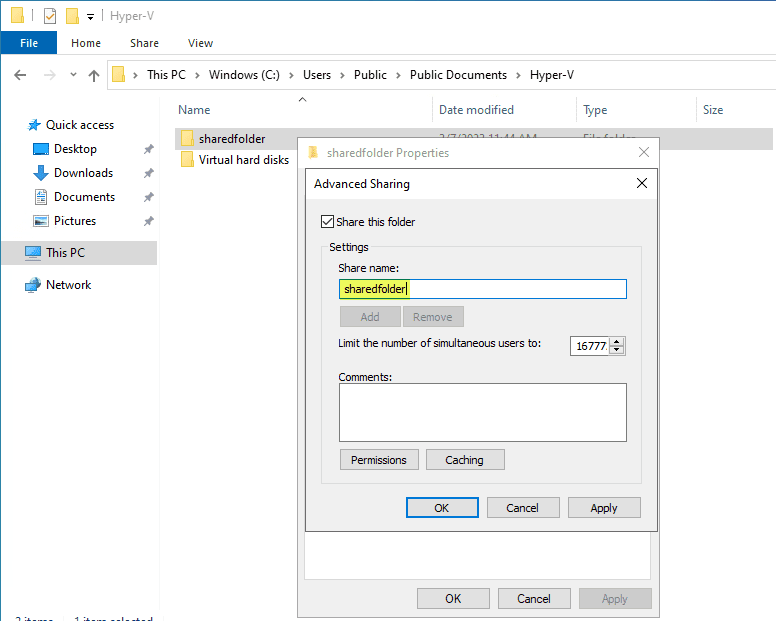
Use a passthrough disk
A Hyper-V passthrough disk allows Hyper-V guest virtual machines to access physical disks attached to your Hyper-V host, such as an external USB drive. It is a convenient way to present hardware storage devices to virtual machines, allowing them to access physical attached storage.
Once you attach your physical storage to your Hyper-V server, you will need to set the disk to an Offline state. Once the disk is unused on the Hyper-V host, you can pass the disk through to a Hyper-V guest virtual machine.
Launch Hyper-V Manager
- Select your VM
- Click on the “Settings” option
- In the left pane, select the “Add Hardware” option
- In the right pane, select the SCSI Controller > Hard Disk > Add
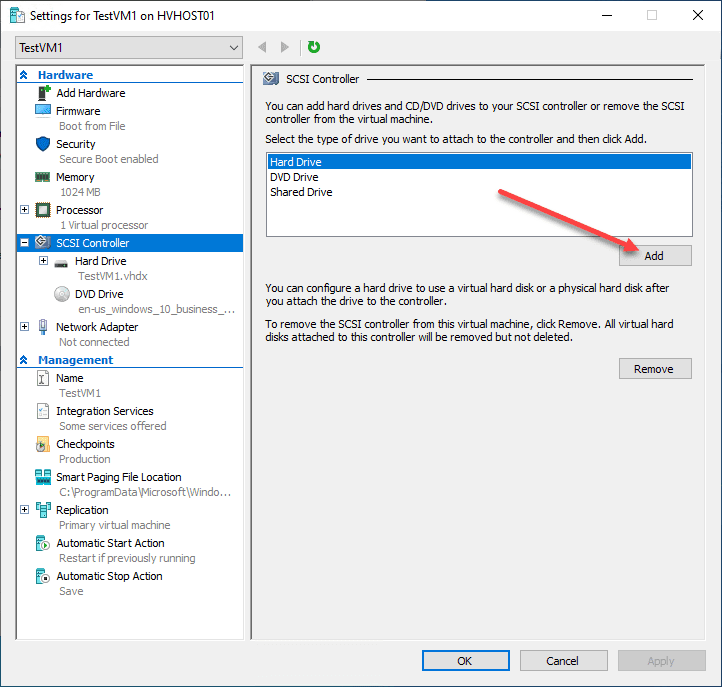
Use enhanced session mode
Enhanced session mode with Hyper-V provides a great way to share resources with guest virtual machines. With the enhanced session mode, you can share resources with your client you are connecting from, which can be your Hyper-V host, or another management workstation.
Enhanced session mode is based on RDP technology which allows sharing locally attached resources with your guest virtual machines. First you need to enable enhanced session mode on your Hyper-V host.
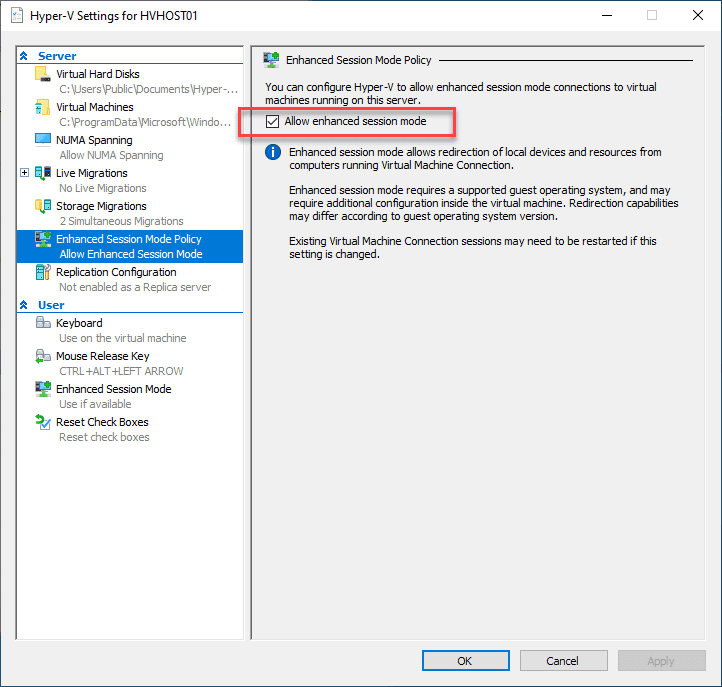
Next, you can use VMConnect.exe and redirect local devices, including USB storage devices, to your Hyper-V virtual machine.
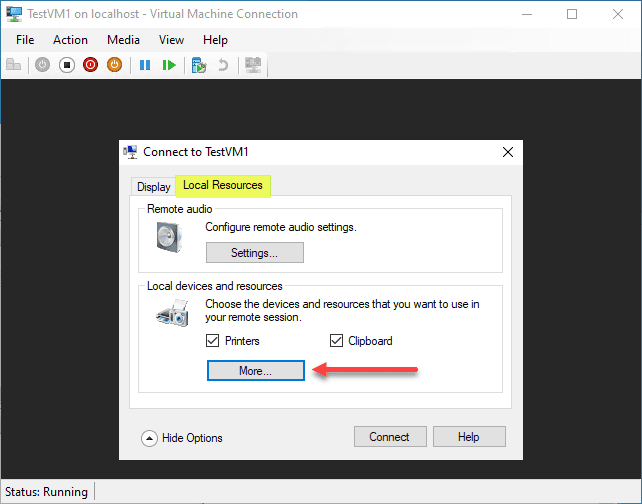
Select the resource attached to your Hyper-V host you want to redirect to your virtual machine.
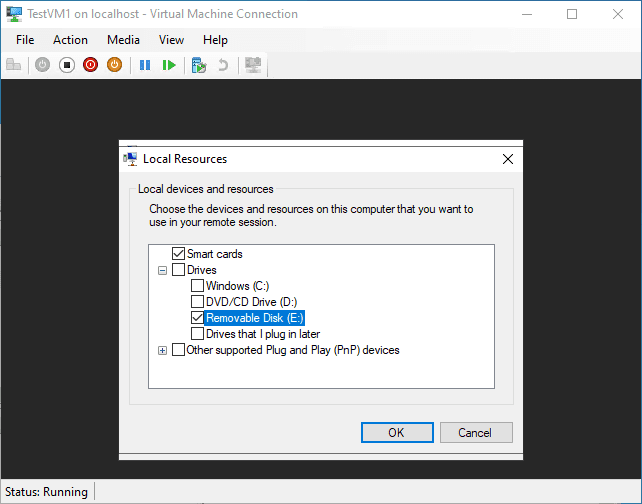
Shared Folder Hyper-V FAQs
Can I access a shared folder in Hyper-V from a remote computer?
Shared folders can be utilized as long as the host is setup for remote access to the shared folder, permissions are configured correctly, and any firewall restrictions are configured for the remote access from a client to access the Hyper-V host.
How can I troubleshoot issues with accessing a shared folder in Hyper-V?
Problems accessing shared folders in Hyper-V generally come down to improperly configured permissions, or issues with the Windows Firewall configuration that may be filtering ports required for network connectivity. For enhanced session mode to work, it needs to be enabled on the Hyper-V host configuration. For pass-through disks, ensure the disk is not claimed by the Hyper-V host.
What methods can you use to share folders or other resources in Hyper-V?
You can use a traditional shared network folder, pass-through disks, or enhanced session mode to share resources between your Hyper-V host or another client computer with guest Hyper-V virtual machines.
Wrapping up
Hyper-V is a powerful virtualization platform that provides many ways to share resources between the host and guest virtual machines. We have discussed a few of those ways in this post, including setting up a traditional file share, using a pass-through disk, and taking advantage of enhanced session mode. By taking advantage of these means to share resources, Hyper-V admins can share files effectively between host and guests and eliminate the need to add additional virtual infrastructure to guest operating systems simply to share files and other resources.
Read More:
Beginners’ Guide for Microsoft Hyper-V: Hyper-V vs VirtualBox Virtualization – Part 63
Hyper-V Mastery: A Step-by-Step Guide for Beginners to Elevate Your IT Skills and Boost Your Career
Follow our Twitter and Facebook feeds for new releases, updates, insightful posts and more.



Leave A Comment